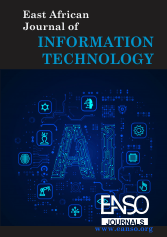Artificial Intelligence and Cultural Tourism in Kenya: A Systematic Review of Development Opportunities and Challenges
Abstract
This paper presents a systematic review of the intersection between artificial intelligence (AI) and cultural tourism in Kenya, with a particular focus on the Mount Kenya region. It examines the potential of AI to enhance sustainable cultural tourism through digital heritage preservation, targeted marketing, and enriched visitor experiences. The study employs a qualitative systematic review methodology, analyzing peer-reviewed journal articles, policy documents, case studies, and global best practices relevant to AI applications in cultural tourism. Thematic analysis was used to identify recurring patterns, opportunities, and challenges. The findings reveal that AI holds considerable promise in addressing infrastructure gaps, enhancing inclusivity, and increasing the global visibility of Kenya’s cultural heritage. Nonetheless, inadequate policy frameworks, inadequate financial investment, and widespread digital illiteracy are among the substantial challenges that have persisted. This study has made recommendations on the formulation of a vigorous policy context, investing in digital capacity building, and promoting public-private partnerships (PPTS) to realize an enabling environment for AI-integrated cultural tourism in Kenya
Downloads
References
Abebe, A., & Teka, M. (2021). Digital literacy and tourism development in sub-Saharan Africa. African Journal of Tourism Research, 9(2), 105–119.
Akama, J. S., & Kieti, D. M. (2019). Rethinking the role of cultural tourism in Kenya. Tourism Management Perspectives, 29, 89–97.
Akama, J. S., & Kieti, D. M. (2019). Tourism and socio-economic development in developing countries: A case study of Mombasa Resort in Kenya. Journal of Sustainable Tourism, 27(6), 869–884.
Akama, J. S., & Kieti, D. M. (2019). Tourism and sustainable development in Kenya: Identifying policy gaps. Journal of Sustainable Tourism, 27(4), 523– 540. https://doi.org/10.1080/09669582.2019.1578365
Benamar, A., & Boutaleb, S. (2021). Artificial intelligence in African tourism: Lessons from South Africa. International Journal of Tourism Research, 23(3), 221–233.
Benamar, N., & Boutaleb, M. (2021). Artificial intelligence policy in Africa: Challenges and perspectives. International Journal of Digital Policy & Governance, 2(3), 45–61.
Benamar, N., & Boutaleb, S. (2021). Digitizing African heritage through artificial intelligence. International Journal of Heritage Studies, 27(4), 394–411.
Buhalis, D., & Amaranggana, A. (2014, December). Smart tourism destinations enhancing tourism experience through personalisation of services. In Information and communication technologies in tourism 2015: Proceedings of the international conference in Lugano, Switzerland, February 3-6, 2015 (pp. 377-389). Cham: Springer International Publishing.
Huang, M.-H., & Rust, R. T. (2021). A strategic framework for artificial intelligence in marketing. Journal of the Academy of Marketing Science, 49(1), 30–50. https://doi.org/10.1007/s11747-020-00749-9
Kamau, N. (2023). Cultural Marginalization and Sustainable Tourism: A Focus on the Ndorobo and Mukogodo in Kenya. African Journal of Tourism Research, 9(1), 45–62.
Kamau, P. M. (2023). Inclusivity in Kenya's cultural tourism: A case of marginalized communities. Kenya Tourism Review, 12(1), 55–67.
Kamau, W. (2023). Cultural exclusion and tourism development in Mount Kenya. Kenya Heritage Studies, 11(1), 14–29.
Manovich, L. (2020). AI aesthetics: Artificial intelligence and cultural heritage. Digital Culture & Society, 6(1), 23–39.
Mariani, M. M., & Borghi, M. (2021). Industry 4.0: A bibliometric review of its managerial intellectual structure and potential future research avenues. Technological Forecasting and Social Change, 165, 120487. https://doi.org/10.1016/j.techfore.2020.120487
Msuya, C., & Kihwele, J. (2022). Digital storytelling and heritage preservation in East Africa: The role of AI tools. African Journal of Heritage Studies, 7(2), 33–51.
Msuya, T., & Kihwele, D. (2022). Digital transformation and cultural heritage: A review of East African tourism strategies. Journal of African Tourism Studies, 5(2), 75–93.
Msuya, Z., & Kihwele, D. (2022). Infrastructure and policy gaps in East Africa’s tourism development. East African Journal of Policy Studies, 18(1), 67–83.
Rinaldi, A. M. (2020). Digital museums and cultural tourism in Europe: The VAST project experience. Tourism Review International, 24(1), 1– 15. https://doi.org/10.3727/154427220X15758301240990
Rinaldi, L. (2020). AI and the future of cultural tourism. Journal of Tourism Futures, 6(2), 110–124.
UNESCO. (2021). Artificial intelligence and cultural diversity: Challenges and opportunities. United Nations Educational, Scientific and Cultural Organization. https://unesdoc.unesco.org/
UNESCO. (2021). Artificial Intelligence and Cultural Heritage. Retrieved from https://en.unesco.org
UNWTO. (2020). International Tourism Highlights. United Nations World Tourism Organization.
UNWTO. (2020). International Tourism Highlights: 2020 Edition. Retrieved from https://www.unwto.org
UNWTO. (2020). Tourism and culture synergies. United Nations World Tourism Organization. https://www.e-unwto.org/
UNWTO. (2023). Tourism and cultural heritage: Global trends. United Nations World Tourism Organization.
World Bank. (2023). Digital Kenya: Technology for inclusive development. https://www.worldbank.org/
Copyright (c) 2025 Julius Benard Rajwais, Laban Kipkemoi Rotich, PhD, Isabella Cheloti Mapelu, PhD

This work is licensed under a Creative Commons Attribution 4.0 International License.




























